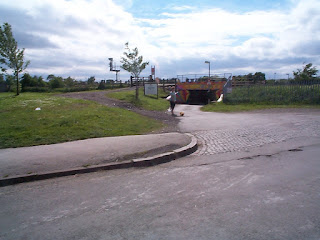November's Derby Telegraph article, hot off the press (if they have such things nowadays) tells of my brief flirtation with militancy ;-)
You can find the whole sordid story on the Derby Telegraph Bygones website here, or read on below:
and here's the unedited content:
Last month, I was writing about
my minor act of rebellion in leaving the work’s radio on over and above the
allotted hour, which was popular with the girls working in Harold Wesley Ltd.
in the 1970s, but less so with the management.
Recalling this reminded me that I had actually been a little more
rebellious than that, not that it actually got me anywhere.
The 1970s marked the height of
trade union membership in the U.K., with over 13.2 million members in 1979 and
a corresponding 29.5 million days lost to industrial disputes, whereas in 2009
there were just over 7 million members and just 455,000 days lost. Industrial strife impacted on all of us at
some point. I’ve written before about
the eerie quiet of the factory and the difficulty of trying to work by
torchlight during the 3 day week in the winter of 1973-1974. Not a T.V. news bulletin went by without the
sight of masses of men, at some factory or other (usually in the motor
industry) dutifully raising their hands to signify their readiness to walk out
on strike. Against this background,
Wesley’s was something of an oddity in that it had no trade union presence, now
or in its history.
I think the original Harold
Wesley might have been something of an enlightened factory owner in his
day. Certainly, the ancient letterheads
we still used showed the H.Q. in Harlesden surrounded by green fields and with
happy employees playing healthy sports.
Whether it was like this, or had ever been, I couldn’t comment as I was
never important enough to go down there, but the Burton paper mill had none of
these advantages.
For example, the catering
provision for the shop-floor staff, when I first joined, was pretty dire
indeed. It consisted of a run-down ancient
cottage in the grounds of the factory, filled with third-hand furniture and
some dodgy, and distinctly unsanitary-looking kitchen equipment, including a
stove on which a kettle was permanently boiling, filling the place with
steam. During my time there, we did move
to proper vending machines for tea and coffee but that was about as good as it
got.
It was hardly surprising,
therefore, that a recent recruit to our warehousing staff was appalled at the
low wages and poor provision for the workers and started to recruit as many as
he could into joining his union, which was the Transport and General Workers
Union (TGWU). Inspired by this, I thought it was a shame
that the management and clerical staff were going to be left behind and I tried
to encourage a number of them to join the relatively new trade union, ASTMS
(Association of Scientific, Technical and Managerial Staffs) recently launched
by Clive Jenkins, the charismatic Welsh trade unionist. This was quite daring of me, really, because
I felt sure that my days at Wesley’s would be numbered if it was ever found
that I had been stirring up dissent in the ranks. I think it even went as far as a
representative of ASTMS coming down to the factory to talk to our M.D., but as they
had no membership at that time, I think he was sent off with ‘a flea in his
ear’. Ultimately, although the various
managers listened to me politely and quite agreed that our terms and conditions
were pretty poor, no-one was willing to take the leap and join a union.
Things were different on the shop
floor, however. The warehouse bloke had
been successful in getting a reasonable number to sign up to the TGWU and,
inevitably, a District Official from that union came to talk to our M.D. about
union representation. It was at that
point that our management obviously realised that they had to make some
concessions, but they decreed that, whilst they were willing to recognise a
trade union, it should be one appropriate to the industry, which is how we came
to have the wonderfully named Society of Graphical and Allied Trades (SOGAT)
with their titles for their branch officials of Father of the Chapel and Mother
of the Chapel, which, when you think about it, was rather appropriate for a
firm called Wesley’s!
You can find all of the stories leading up to this, plus a whole lot more, in the brand new bumper 'nostalgedy' collection 'The Things You See...' available now at the special introductory price of just £1.49.








